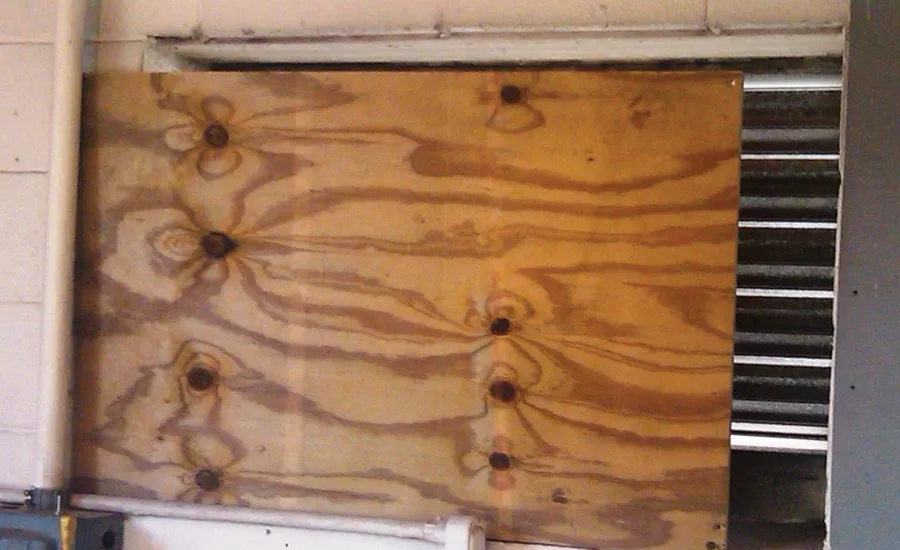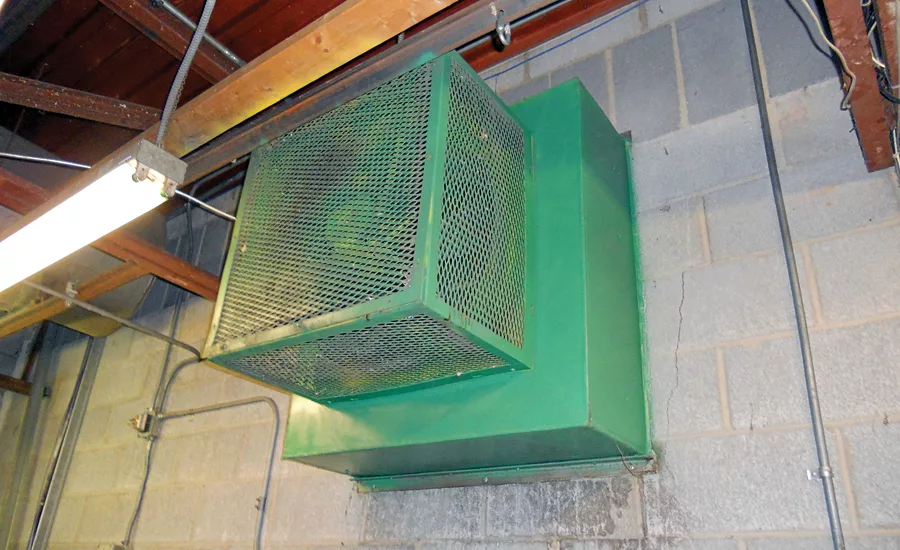Can the boiler breathe?
The free area of an opening determines how much combustion air can be delivered to the boiler room.

When combustion air openings are blocked, such as this one, boilers and water heaters can be starved of air. Photo credit: Ray Wohlfarth

Exhaust fans in boiler rooms can pull the flue gases from the burner into the main building. Photo credit: Ray Wohlfarth
I was a young apprentice working with a journeyman technician in a boiler room and he explained how to determine the combustion air required for a boiler room. He measured the existing louvers and calculated the free area of the opening using paper and pencil. The free area of an opening determines how much combustion air can be delivered to the boiler room.
After completing his calculations, he announced the existing grill was too small for the boiler room. He pulled out a hammer from his metal tool box and broke one of the glass panes from the window.
“There,” he said. Just at that time, the owner walked into the room. “What are you doing?” he demanded. “Didn’t have enough combustion air, so I fixed it,” the tech said proudly.
It was the first and only time I was ordered to leave a jobsite. The journeyman was fired by the boss and I was reprimanded. Although the journeyman was wrong in his decision to break the glass without the owner’s permission, he instilled in me the importance of checking the combustion air openings on every service call. As a grizzled old boiler room veteran now, I see many boiler rooms with inadequate combustion air.
According to the International Fuel Gas Code, Section 304, each boiler room should have two openings, one within 1 ft. of the floor and one within 1 ft. of the ceiling. This is to allow natural ventilation inside the boiler room. The dual openings also limit the possibility of a single opening being blocked and starving the boiler or water heater for air. I see many boiler rooms with the combustion air opening accidently blocked by either leaves or garbage or purposely blocked by wood or cardboard.
Sizing combustion openings
The International Fuel Gas Code requires the following combustion air openings for a boiler room:
-
Vertical opening: 1 in. free area for each 4,000 Btuh input of gas-burning appliances in the room.
-
Horizontal duct opening: 1 in. free area for each 2,000 Btuh input of gas-burning appliances in the room.
-
Mechanical fan: One CFM of air for each 2,400 Btuh input of gas-burning appliances in the room.
-
Indoor air: 50 cubic ft. of area for each 1,000 Btuh of the appliances.
To properly size the combustion air openings, add the input of all fuel-burning equipment inside the boiler room. Let us assume we have a 40 gal., 40,000 Btuh water heater and a 200,000 Btuh boiler for a total of 240,000 Btuh in a room with two vertical openings with metal louvers. The calculations are:
-
240,000 divided by two openings equals 120,000 each opening.
-
120,000 divided by 4,000 Btuh equals 30 in. free area required.
If we assume the free area of each metal louver to be 75% of the total size, we would need two grills each sized at 40 sq. in. each.
If we open a 10-in. by 10-in. hole in the wall, we will have a 100-sq.-in. opening. That would not be a good thing as critters and birds could come right into the room. So we install a metal louver with a screen in the opening. This will not deliver the same amount of air as a wide open hole because of the restrictions of the louvers and screen. The louver manufacturer should be able to provide you with the actual free area or aK factor of the louver.
If it is not available, I use a factor of 75% free area for metal louvers. Our free area of the 10-in. by 10-in. opening is now 75 sq. in. instead of 100 sq. in. That opening would be large enough for 300,000 Btuh. The following are some rules of thumb on free area for other combustion air openings:
-
Wooden louvers — 25% free area.
-
Metal screens — 98% free area.
-
Motorized dampers — 95% free area.
Proper ventilation
If you opt to use a fan for mechanical ventilation, you will need 1 CFM for every 2,400 Btuh. You also will need an interlock to verify the fan is operating before the boiler or water heater starts.
Many residential boiler installations are relegated to a small closet and expected to work properly. When using indoor air for combustion, the boiler room should have 50 cubic ft. of volume per 1,000 Btuh of fuel-burning components. If the same system noted previously is using indoor combustion air instead of outside air, the following is the size room we would need:
• 240,000 total Btuh divided by 1,000 equals 240.
• 240 by 50 (cubic ft. per 1,000 Btuh) equals 12,000 cubic ft.
Assuming we have a 12-ft.-high ceiling, our boiler room would require an area of 1,000 sq. ft. or a boiler room roughly 32 ft. by 32 ft. If the room does not have that much space, you can install a combustion air fan to introduce air to the room. Wire the fan to operate at any time the water heater or boiler is operating.
If the boiler room has an exhaust fan, it could adversely affect the venting of the flue gases. A mere -3/100” W.C. can pull the flue gases from an atmospheric burner or pilot. This could allow the dangerous flue gases into the building.
If you are using motorized combustion air dampers, ASME CSD1 code calls for an interlock on the driven damper so as not to start the boiler until the damper is open.
I have been inside many boiler rooms where the combustion air openings were blocked. As service technicians, I believe we have a duty to explain to building owners the importance of combustion air. I offer to remove the blockage and if they refuse, I will put something in writing about advising them of the danger. If something happens, youwere the last one there.
I like to check the outside of the louvers to make sure they are clean and unobstructed. I have found them blocked by grass clippings, old newspapers and plastic shopping bags.
Make sure your boiler can breathe and stay safe.
Looking for a reprint of this article?
From high-res PDFs to custom plaques, order your copy today!





